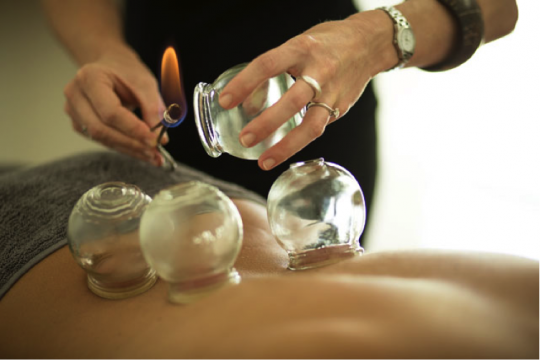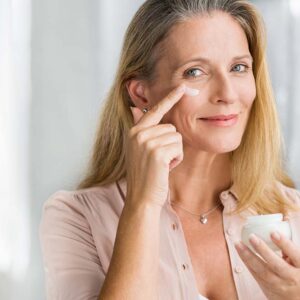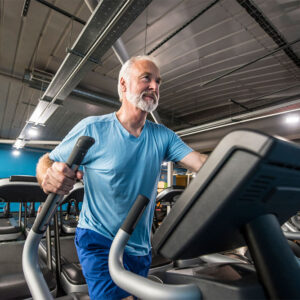
Michael Phelps' Pain Relief Secret Revealed
- Weird black and blue dots may be the secret to Olympic success
- Discover how this ancient therapy can relieve your muscle soreness and boost your overall well-being
- Find out how I got results without discomfort or bruising (photos).
Dear Living Well Daily Reader,
If you’ve watched only five minutes of Olympic coverage, then you’ve probably seen the dark purple circles that dot Michael Phelps’ body.
You know, the numerous large blemishes that mark his arms, shoulders and back. The ones that might make you think he got into a rumble at a Rio bar if they weren’t so perfectly round.

Phelps’ upper body covered in cupping marks during the 2016 Olympic Games. Source: Dailymail.co
But Phelps hasn’t gotten into any post-event barroom brawls (that we know of, anyway).
Instead, he’s secured his legacy as the most decorated Olympian of all time.
And the black and blue circles on his arms, back and shoulders are caused by an ancient Eastern medicine technique called cupping, which is used to treat a variety of conditions from muscle soreness to immune issues.
The real question is… does it work?
Since the use of cupping for pain relief goes back thousands of years to ancient Egyptian, Chinese and Middle Eastern medicine, it would make sense this therapy gets results.
So I decided to try it. I’ll tell you all about my cupping experience (photos included) in just a bit. First, let’s take a closer look at cupping.
![]() Ancient Therapy, Modern Results
Ancient Therapy, Modern Results
Traditional cupping therapy uses cups made of glass, earthenware or bamboo.
To get one of these traditional cups to stick, the therapist uses a flame inside the cup. This heat creates the suction needed for the therapy, sucking the skin and underlying tissue into the cup. The cups are placed on acupuncture points on the body.

A therapist preparing a cup with fire. Source: The acupuncturecompany.com
However, this method doesn’t allow the practitioner to control the level of suction you will receive. For this reason, many practitioners and homes users alike prefer hand-pump cups (which I also opted for).
Cupping is often described as “a reverse massage.” In massage, the therapist applies pressure to sore areas to break down toxins and flush them from the muscles into the bloodstream. But in cupping, the suction brings the blood to areas that wouldn’t normally have it. This increased circulation stimulates acupuncture points, which in turn, help to detoxify and relax muscles through the release of connective tissue.
Dr. Ed Lamadrid, a sports acupuncturist, explains further:
Cupping is all about circulation — it brings blood to areas that don’t normally have it. It actually sucks the skin into the cup, releasing the connective tissue underneath the skin that wraps your muscles. Now the muscles are able to move freely without the restriction. As we get tense and tight, the connective tissue that wraps around every single muscle starts twisting, and that’s why you think something’s wrong… but nothing is wrong with your muscle. It’s the covering of the muscle that’s actually tightening up. You release that envelope and your muscle’s range of motion is improved.
According to a systematic review in Acupuncture in Medicine, “Cupping therapy is promising for pain control and improvement of quality of life.” Other studies have found cupping to have positive results on pain, but some of these attribute it to the placebo effect. Many experts agree that more research needs to be done on the health effects of cupping.
Some folks claim that cupping benefits aren’t limited to just muscle recovery. Traditionally, cupping’s been used to treat anything from arthritis to mental illness. In modern times, it’s being used for cellulite control, rejuvenation and immune system support as well.
Personally, I used cupping to relieve a long-standing pain in my shoulder.
![]() Cupping Results Don’t Suck
Cupping Results Don’t Suck
As I mentioned earlier, I used a hand-pump cup system. There were two reasons for this:
- It’s cheap. The going rate for a 30-minute cupping session here in Baltimore is $50, whereas the hand-pump kit (which includes 15 cups and the pump) costs $16, and I can use it repeatedly.
- I’m a tad afraid of fire, so the thought of an open flame being used near my bare skin is a little too much for me.
It took me a few tries to get the cups working, but once I got the hang of it — with the help of a extender tube — I was able to cup just about anywhere on my body. However, it’s much easier to have the help of a partner (which I eventually opted for) when attempting to cup any part on the back of the body.
I chose a particular spot on my left shoulder because it always hurts. Even with a regular stretching routine and frequent massage, this spot remains troublesome.
My friend placed the cup on the spot and used the hand pump to create a moderate amount of suction.

Initially, the suction felt a bit uncomfortable, but I quickly became accustomed to it. Around five minutes in, I began to feel tingling in the muscles around my shoulder, in my neck and down my arm. I experience the same sensation when getting deep tissue massage.
I left the cup on for 35 minutes. It was easy to remove and didn’t leave too much of a mark.

Incredibly, my shoulder felt less stiff and my range of motion increased instantly. After a night of rest, my shoulder pain was almost gone. I was amazed at how quickly the cupping had brought me relief. And the best part — I didn’t wake up with a giant bruise, just a bit of discoloration. This may be due to the moderate pressure and/or the short duration of the session.

From now on, I will be cupping this troublesome spot on my shoulder as well as other sore spots.
While cupping won’t get you (or me) into Olympic shape, it may relieve muscle soreness and boost your range of motion. It seems to work for Phelps, who brought home his 23rd gold medal this summer — extending his all-time gold medal record.
If you want to try cupping, you can buy the same set I used here.
Live well,

Natalie Moore
Managing editor, Living Well Daily
Sources
[2] Local massage therapist explains cupping
[3] Why Michael Phelps, other Olympic athletes use cupping therapy for recovery
[4] Effectiveness of cupping therapy for low back pain: a systematic review
Written By Natalie Moore
Natalie Moore is a dedicated health researcher with a passion for finding healthy, natural, and science-based solutions. After a decade of direct healthcare experience in western and natural medicine, she was involved in public health research before joining Living Well Daily.
View More Free Articles
The Secret Ingredient to a Longer, Happier Life
Let’s face it. We’re all in need of an attitude adjustment from time to time. After all, when you turn on the news these days, the world can seem pretty dark. That is unless you make it a practice to look for the silver linings. In fact, Harvard researchers say when you do, something quite...
Do You REALLY Need All Those Skincare Products?
I often get questions about skincare products—and here’s what I’ve learned. In today’s beauty-obsessed world, it’s easy to fall into the trap of spending hundreds every month believing you need countless products to fight aging and achieve healthy, glowing skin. However, many dermatologists argue that LESS is MORE when it comes to skincare. Simplifying your...
“Ebb and Flow” Technique TRANSFORMS Senior Brain Health
You know by now that exercise is good for you. It keeps your heart healthy, your muscles strong, and your waistline trim. But what if I told you that a trendy “ebb and flow” workout technique—often associated with young fitness enthusiasts—could actually be a game-changer for us “oldsters” when it comes to brain health? And...
Mailbag: Slash Your Risk of Bone Fractures as You Age
“My doctor recently told me that I have osteoporosis. What can I do to reduce my risk of fractures and maintain strong bones as I age?” – Margaret Hi Margaret, Sorry to hear about your diagnosis. I’m sure it was a shock. Osteoporosis is a serious condition that affects millions of people, and it’s not...
Household Favorite EXPOSED as Cancer Risk?
We all want to believe that the products we use daily are safe. After all, if they weren’t, they wouldn’t be on store shelves, right? Well, I hate to break it to you, but sometimes, the truth is far more alarming than we’d like to admit. The World Health Organization (WHO) has just dropped a...
Hidden Heatwave Threat REVEALED
Heat waves can have serious consequences. After all, staying cool isn’t just a comfort issue. When the mercury soars, it threatens your health—especially when you’re a senior. There are various reasons for this, including chronic medical conditions and bodies that just don’t regulate temperature as well as they once did. But there’s another heat-linked threat...
The Hidden Threat Behind Your Achy Joints
Picture this… You’re trying to enjoy a leisurely stroll in the park, but each step sends a jolt of pain through your knee. Or maybe you’re attempting to open a stubborn jar lid, only to have your fingers refuse to cooperate, leaving you feeling frustrated and helpless. Perhaps you’re simply trying to get out of...
Parkinson's Signs You Can't Afford to Miss
Imagine waking up one day to find your body betraying you. Your hands tremble as you try to button your shirt. Your feet shuffle when you want to walk with purpose. Once strong and clear, your voice now barely reaches above a whisper. This is the reality for those living with Parkinson’s. But what if...
Do Protein Needs Drop with Age? The SURPRISING Answer
I had a patient ask me the other day if they needed as much protein now as when they were younger. After all, we aren’t quite as active as seniors compared to when we were spring chickens. It’s a good question. And the answer might surprise you… Remember when you could devour a whole pizza...
Follow Your “Gut Feeling” to Reduce Diabetes Risk
It seems like every day we learn something new about the incredible influence our gut has on our overall health. From mood to immunity, and even to how well we sleep, the community of microbes in our digestive tract is pulling the strings behind the scenes. So, it should come as no surprise that researchers...









